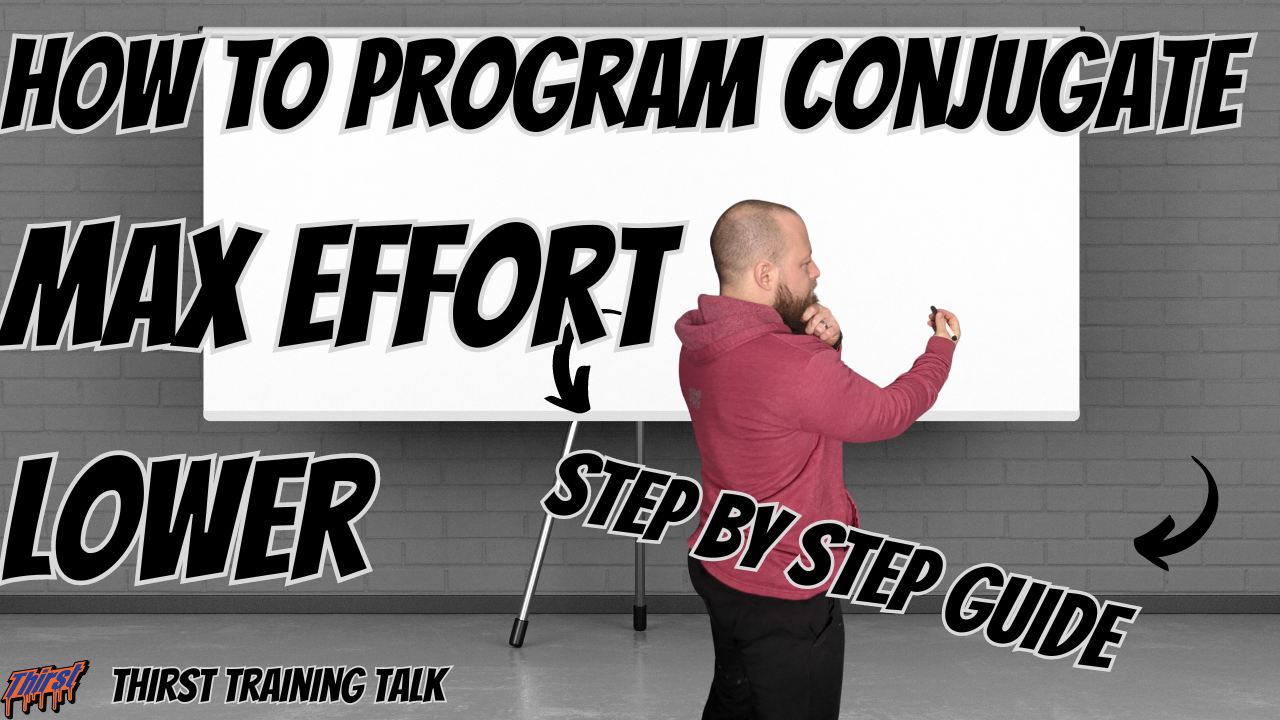The Complete Guide to Max Effort Lower Body Training: A Modern Approach to Conjugate Training
For raw powerlifters and strength athletes looking to optimize their squat performance, understanding how to properly structure max effort lower body training is crucial. While the conjugate system, popularized by Louie Simmons at Westside Barbell, provides an excellent framework, today’s athletes often need modifications to suit their specific needs. In this comprehensive guide, I’ll break down my approach to max effort lower body training, specifically tailored for raw lifters.
Don’t want to take the time to read this article? Well, I’ve created a video where I walk you through this step by step below.
Key Takeaways
- Focus primarily on squat variations for max effort work
- Implement strategic back-down sets for enhanced volume
- Structure accessory work to support main movement patterns
- Maintain optimal training session length (90-120 minutes)
Why Emphasize Squat Variations?
A key difference in my approach compared to traditional conjugate methods is the emphasis on squat variations during max effort lower body days. The reasoning is simple: raw lifters typically recover better from heavy squatting than heavy deadlifting. This allows us to maintain higher frequency and quality in our training while managing fatigue effectively.
The Max Effort Lower Body Training Structure
A1: Primary Max Effort Movement
The cornerstone of the session is your main squat variation. Here’s how to approach it:
- Work up to a 3-Rep Max (3RM)
- Target RPE: 9-9.5
- This typically represents 90-92.5% of your 1RM
- Provides optimal balance of intensity and volume
- Increases time under tension compared to single reps
- Back-Down Sets
- 2-3 sets of 2-5 reps
- RPE 8 (approximately)
- Maintains quality volume at high intensities
- Typically falls in the 85-87% range
B: Primary Supplemental Exercise
Choose a movement that addresses your specific weaknesses. For example:
- SSB Pause Squat (addressing bottom position weakness)
- Programming Guidelines:
- 1-3 sets
- 3-8 reps (typically 3-5 for strength focus)
- RPE 7-8
- Adjust volume based on training phase
C: Heavy Accessory Movement
Focus on unilateral or quad-dominant exercises:
Options include:
- Goblet squats
- Leg press
- Hack squat
- Bulgarian split squats
- Front foot elevated split squats
- SSB lunges
Programming Guidelines:
- 3-4 sets
- 6-12 reps
- Adjust rep ranges based on hypertrophy needs
D: Isolation/Secondary Movement
Choose quad-dominant exercises such as:
- Leg extensions
- Spanish squats
- Reverse sled drags
- Heels elevated goblet squats
Programming Guidelines:
- 2-3 sets
- 10-20 reps
- Focus on quality movement and muscle activation
E: Finishing Movements (E1 & E2)
E1: Posterior Chain Work
Choose from:
- Reverse hypers
- Back extensions
- Leg curls
- Pull-throughs
- RDL variations
Programming Guidelines:
- 3-5 sets
- 10-20 reps
- Adjust based on recovery needs
E2: Core Work
Focus on flexion-based movements:
- Hanging leg raises
- Reverse crunches
- Standing abs
- Half Turkish get-ups
- Various situp variations
Programming Guidelines:
- 3-5 sets
- 10-20 reps or to technical failure
- Emphasize quality over quantity
Programming Considerations
The 80/20 Rule
The first two movements (A1 and B) should account for approximately 80% of your results. If time is limited, prioritize these movements while reducing volume on accessory work.
Upper Back Integration
While traditional conjugate training emphasizes dedicated upper back work, this program incorporates it through:
- Safety squat bar usage
- Anterior loaded positions (goblet variations)
- Static strength development through positioning
Session Structure
- Total duration: 90-120 minutes
- Primary focus on A1 and B movements
- Progressive reduction in intensity through the session
- Exercises build upon each other (E drives D, D drives C, etc.)
When to Modify Exercise Selection
Consider changing exercises when:
- Progress stalls on main movements
- Technical proficiency plateaus
- Recovery becomes compromised
- New weaknesses emerge
Conclusion
This approach to max effort lower body training provides a structured framework while maintaining flexibility for individual needs. By focusing on squat variations and implementing strategic volume through back-down sets, raw lifters can develop both strength and technical proficiency while managing fatigue effectively.
Remember that this is one interpretation of the conjugate system, specifically adapted for raw lifters. As with any training approach, monitor your progress and adjust variables based on your individual response and goals.
Looking to implement this approach? Apply to work with me one-on-one to deliver your best results and progress.
You can also implement my conjugate for raw powerlifting delivered through Train Heroic for less than $1 per day, and a 7 day free trial!








